7.3.21 GeneralizationSet
A GeneralizationSet is a PackageableElement (from Kernel ) whose instances define collections of subsets of Generalization
relationships.
*Generalizations
•
PackageableElement (from Kernel ) on page 111
*Description
Each Generalization is a binary relationship that relates a specific Classifier to a more general Classifier (i.e., from a
class to its superclasses). Each GeneralizationSet defines a particular set of Generalization relationships that describe
the way in which a general Classifier (or superclass) may be divided using specific subtypes. For example, a GeneralizationSet
could define a partitioning of the class Person into two subclasses: Male Person and Female Person. Here, the GeneralizationSet
would associate two instances of Generalization. Both instances would have Person as the general classifier; however, one
Generalization would involve Male Person as the specific Classifier and the other would involve Female Person as the specific
classifier. In other words, the class Person can here be said to be partitioned into two subclasses: Male Person and Female
Person. Person could also be divided into North American Person, Asian Person, European Person, or something else. This collection
of subsets would define a different GeneralizationSet that would associate with three other Generalization relationships.
All three would have Person as the general Classifier; only the specific classifiers would differ (i.e., North American Person,
Asian Person, and European Person).
*Attributes
Issue 9191 -add default value
• isCovering : Boolean Indicates (via the associated Generalizations) whether or not the set of specific Classifiers are covering
for a particular general classifier. When isCovering is true, every instance of a particular general Classifier is also an
instance of at least one of its specific Classifiers for the GeneralizationSet . When isCovering is false, there are one or
more instances of the particular general Classifier that are not instances of at least one of its specific Classifiers defined
for the GeneralizationSet . For example, Person could have two Generalization relationships each with a different specific
Classifier: Male Person and Female Person. This GeneralizationSet would be covering because every instance of Person would
be an instance of Male Person or Female Person. In contrast, Person could have a three Generalization relationship involving
three specific Classifiers: North American Person, Asian Person, and European Person. This GeneralizationSet would not be
covering because there are instances of Person for which these three specific Classifiers do not apply. The first example,
then, could be read: any Person would be specialized as either being a Male Person or a Female Person— and nothing else; the
second could be read: any Person would be specialized as being North American Person, Asian Person, European Person, or something
else. Default value is false.
Issue 9191 -add default value
• isDisjoint : Boolean Indicates whether or not the set of specific Classifiers in a Generalization relationship have instance
in common. If isDisjoint is true, the specific Classifiers for a particular GeneralizationSet have no members in common; that
is, their intersection is empty. If isDisjoint is false, the specific Classifiers in a particular GeneralizationSet have one
or more members in common; that is, their intersection is not empty. For example, Person could have two Generalization relationships,
each with the different specific Classifier: Manager or Staff. This would be disjoint because every instance of Person must
either be a Manager or Staff. In contrast, Person could have two Generalization relationships involving two specific (and
non-covering) Classifiers: Sales Person and Manager. This GeneralizationSet would not be disjoint because there are instances
of Person that can be a Sales Person and a Manager. Default value is false.
*Associations
• generalization : Generalization [*] Designates the instances of Generalization that are members of a given
GeneralizationSet (see constraint [1] below).
• powertype : Classifier [0..1] Designates the Classifier that is defined as the power type for the associated
GeneralizationSet (see constraint [2] below).
*Constraints
[1] Every Generalization associated with a particular GeneralizationSet must have the same general Classifier.
generalization->collect(g | g.general)->asSet()->size() <= 1
[2] The Classifier that maps to a GeneralizationSet may neither be a specific nor a general Classifier in any of the Generalization
relationships defined for that GeneralizationSet . In other words, a power type may not be an instance of itself nor may its
instances be its subclasses.
*Semantics
The generalizationSet association designates the collection of subsets to which the Generalization link belongs. All of the
Generalization links that share a given general Classifier are divided into subsets (e.g., partitions or overlapping subset
groups) using the generalizationSet association. Each collection of subsets represents an orthogonal dimension of specialization
of the general Classifier.
As mentioned above, in essence, a power type is a class whose instances are subclasses of another class. Power types, then,
are metaclasses with an extra twist: the instances can also be subclasses. The powertype association relates a classifier
to the instances of that classifier, which are the specific classifiers identified for a GeneralizationSet . For example, the
Bank Account Type classifier could associate with a GeneralizationSet that has Generalizations with specific classifiers of
Checking Account and Savings Account. Here, then, Checking Account and Savings Account are instances of Bank Account Type.
Furthermore, if the Generalization relationship has a general classifier of Bank Account, then Checking Account and Savings
Account are also subclasses of Bank Account. Therefore, Checking Account and Savings Account are both instances of Bank Account
Type and subclasses of Bank Account. (For more explanation and examples see
Examples on page 79.)
*Notation
The notation to express the grouping of Generalizations into GeneralizationSet s was presented in the Notation section of Generalization,
above. To indicate whether or not a generalization set is covering and disjoint, each set should be labeled with one of the
constraints indicated below.
{complete, disjoint} -Indicates the generalization set is covering and its specific Classifiers have no common instances.
{incomplete, disjoint} -Indicates the generalization set is not covering and its specific Classifiers have no common instances*.
{complete, overlapping} -Indicates the generalization set is covering and its specific Classifiers do share common instances.
{incomplete, overlapping} -Indicates the generalization set is not covering and its specific Classifiers do share common instances.
* default is {incomplete, disjoint}
Figure 7.45 - Generalization set constraint notation
Graphically, the GeneralizationSet constraints are placed next to the sets, whether the common arrowhead notation is employed
of the dashed line, as illustrated below..
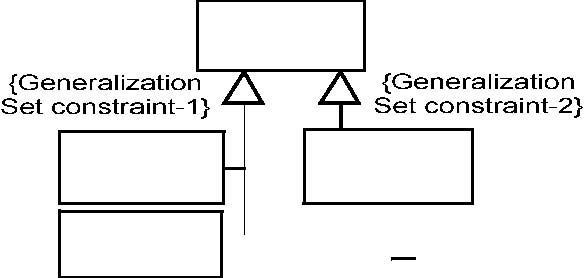
(a) GeneralizationSet constraint when sharing common generalization arrowhead.
{Generalization Set constraint-3} {Generalization Set constraint-4}
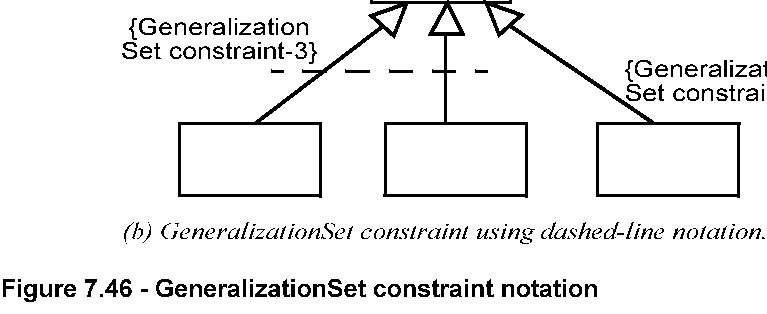 Figure 7.46 - GeneralizationSet constraint notation
Figure 7.46 - GeneralizationSet constraint notation
Power type specification is indicated by placing the name of the powertype Classifier—preceded by a colon—next to the GeneralizationSet
graphically containing the specific classifiers that are the instances of the power type. The illustration below indicates
how this would appear for both the shared arrowhead and the dashed-line notation for GeneralizationSet s.
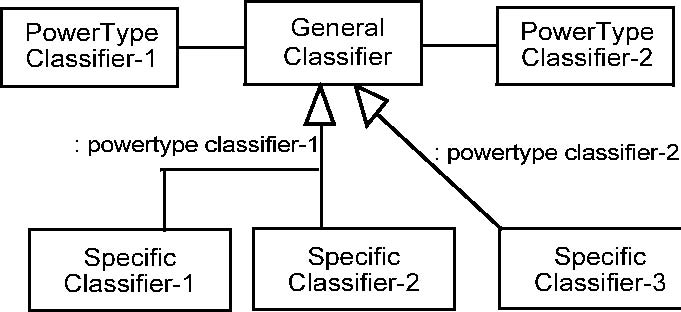
SpecificClassifier-3
(a) Power type specification when sharing common generalization arrowhead
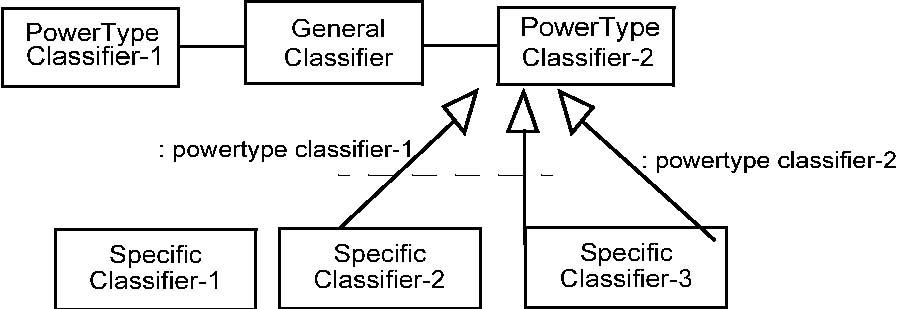
(b) Power type specification using dashed-line notation
Figure 7.47 - Power type notation
*Examples
In the illustration below, the Person class can be specialized as either a Female Person or a Male Person. Because this GeneralizationSet
is partitioned (i.e., is constrained to be complete and disjoint), each instance of Person must either be a Female Person
or a Male Person; that is, it must be one or the other and not both. (Therefore, Person is an abstract class because a Person
object may not exist without being either a Female Person or a Male Person.) Furthermore, a Person object can be specialized
as an Employee. The generalization set here is expressed as {incomplete, disjoint}, which means that instances of Persons
can be subset as Employees or some other unnamed collection that consists of all non-Employee instances. In other words, Persons
can either be an Employee or in the complement of Employee, and not both. Taken together, the diagram indicates that a Person
may be 1) either a Male Person or Female Person, and 2) an Employee or not. When expressed in this manner, it is possible
to partition the instances of a classifier using a disjunctive normal form (DNF).

An incomplete partition indicating that a Person can also be an Employee
A complete partition indicating that a Person
or not. may be subtyped as either a Female Person or a Male Person.
Figure 7.48 - Multiple ways of dividing subtypes (generalization sets) and constraint examples
Grouping the objects in our world by categories, or classes, is an important technique for organizations. For instance, one
of the ways botanists organize trees is by species. In this way, each tree we see can be classified as an American elm, sugar
maple, apricot, saguaro—or some other species of tree. The class diagram below expresses that each Tree Species classifies
zero or more instances of Tree, and each Tree is classified as exactly one Tree Species. For example, one of the instances
of Tree could be the tree in your front yard, the tree in your neighbor’s backyard, or trees at your local nursery. Instances
of Tree Species, such as sugar maple and apricot. Furthermore, this figure indicates the relationships that exist between
these two sets of objects. For instance, the tree in your front yard might be classified as a sugar maple, your neighbor’s
tree as an apricot, and so on. This class diagram expresses that each Tree Species classifies zero or more instances of Tree,
and each Tree is classified as exactly one Tree Species. It also indicates that each Tree Species is identified with a Leaf
Pattern and has a general location in any number of Geographic Locations. For example, the saguaro cactus has leaves reduced
to large spines and is generally found in southern Arizona and northern Sonora. Additionally, this figure indicates each Tree
has an actual location at a particular Geographic Location. In this way, a particular tree could be classified as a saguaro
and be located in Phoenix, Arizona.
Lastly, this diagram illustrates that Tree is subtyped as American Elm, Sugar Maple, Apricot, or Saguaro—or something else.
Each subtype, then, can have its own specialized properties. For instance, each Sugar Maple could have a yearly maple sugar
yield of some given quantity, each Saguaro could be inhabited by zero or more instances of a Gila Woodpecker, and so on. At
first glance, it would seem that a modeler should only use either the Tree Species class or the subclasses of Tree—since the
instances of Tree Species are the same as the subclasses of tree. In other words, it seems redundant to represent both on
the same diagram. Furthermore, having both would seem to cause potential diagram maintenance issues. For instance, if botanists
got together and decided that the American elm should no longer be a species of tree, the American Elm object would then be
removed as an instance of Tree Species. To maintain the integrity of our model in such a situation, the American Elm subtype
of Tree must also be removed. Additionally, if a new species were added as a subtype of Tree, that new species would have
to be added as an instance of Tree Species. The same kind of situation exists if the name of a tree species were changed—both
the subtype of Tree and the instance of Tree Species would have to be modified accordingly.
As it turns out, this apparent redundancy is not a redundancy semantically (although it may be implemented that way). Different
modeling approaches depicted above are not really all that different. In reality, the subtypes of Tree and the instances of
Tree Species are the same objects. In other words, the subtypes of Tree are instances of Tree Species. Furthermore, the instances
of Tree Species are the subtypes of Tree. The fact that an instance of Tree Species is called sugar maple and a subtype of
Tree is called Sugar Maple is no coincidence. The sugar maple instance and Sugar Maple subtype are the same object. The instances
of Tree Species are—as the name implies—types of trees. The subtypes of Tree are—by definition—types of trees. While Tree
may be divided into various collections of subsets (based on size or
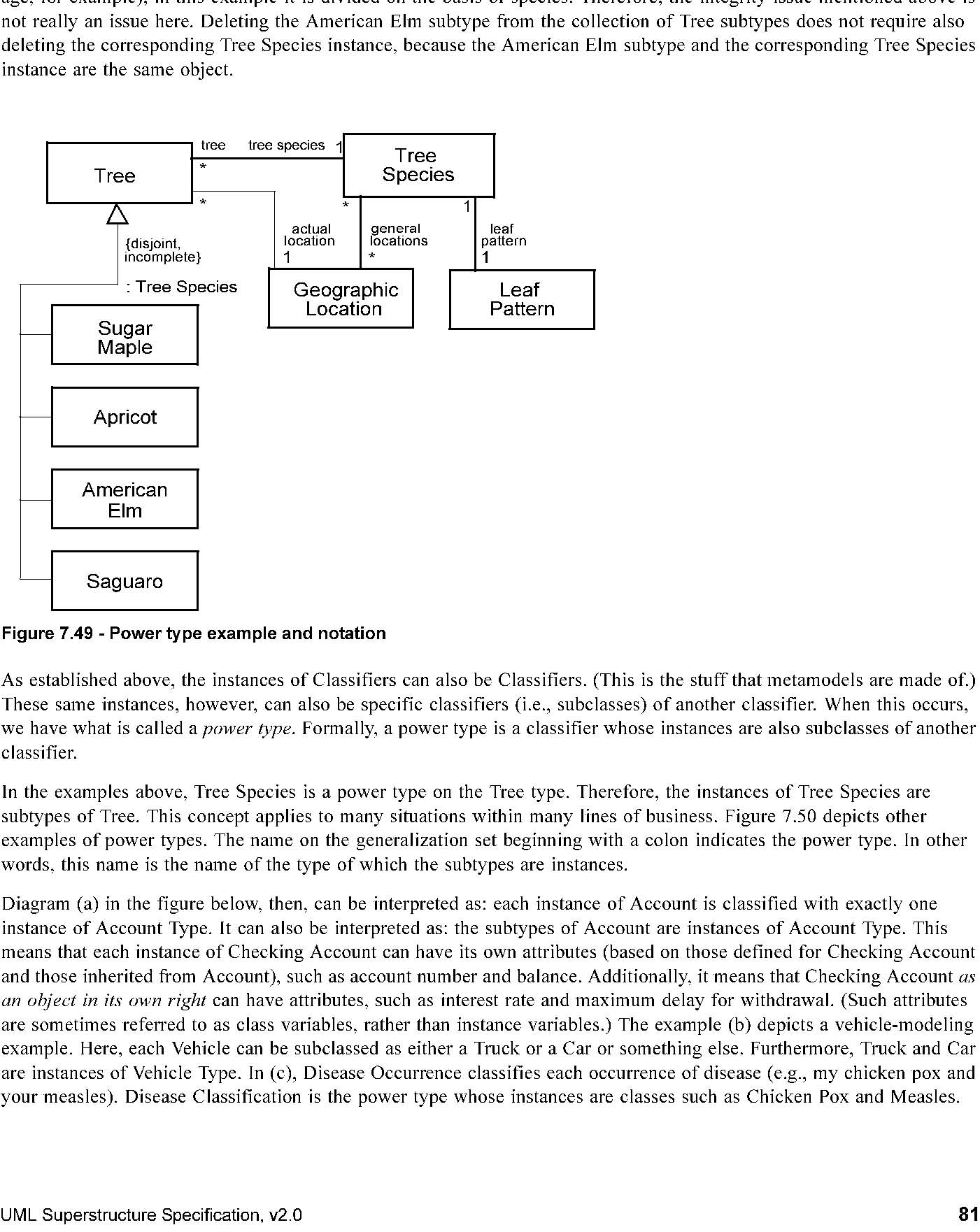
vehicle category
account classifier
1
1
Account
Vehicle
Account
Vehicle
*
Type
*
Type
account

classified vehicle
{disjoint, incomplete}
{disjoint, incomplete}

:Account Type
:Vehicle Type
Checking
Truck
AccountSavings
Car
Account

Figure 7.50 - Other power type examples
Labeling collections of subtypes with the power type becomes increasingly important when a type has more than one power type.
The figure below is one such example. Without knowing which subtype collection contains Policy Coverage Types and which Insurance
Lines, clarity is compromised. This figure depicts an even more complex situation. Here, a power type is expressed with multiple
collections of subtypes. For instance, a Policy can be subtyped as either a Life, Health, Property/Casualty, or some other
Insurance Line. Furthermore, a Property/Casualty policy can be further subtyped as Automobile, Equipment, Inland Marine, or
some other Property/Casualty line of insurance. In other words, the subtypes in the collection labeled Insurance Line are
all instances of the Insurance Line power type.
issued policy
insurance line
Policy
1
*
Insurance
Coverage
Policy
1
*
Line
Type
coverage type
issued policy
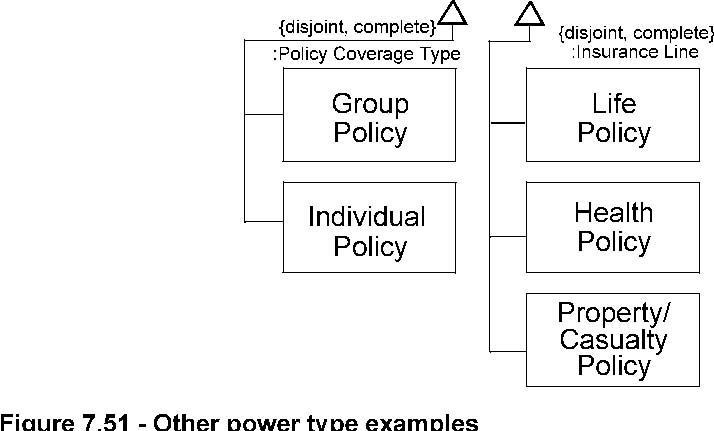 Figure 7.51 - Other power type examples
Figure 7.51 - Other power type examples
Power types are a conceptual, or analysis, notion. They express a real-world situation; however, implementing them may not
be easy and efficient. To implement power types with a relational database would mean that the instances of a relation could
also be relations in their own right. In object-oriented implementations, the instances of a class could also be classes.
However, if the software implementation cannot directly support classes being objects and vice versa, redundant structures
must be defined. In other words, unless you’re programming in Smalltalk or CLOS, the designer must be aware of the integrity
problem of keeping the list of power type instances in sync with the existing subclasses. Without the power type designation,
implementors would not be aware that they need to consider keeping the subclasses in sync with the instances of the power
type; with the power type indication, the implementor knows that a) a data integrity situation exists, and b) how to manage
the integrity situation. For example, if the Life Policy instance of Insurance Line were deleted, the subclass called Life
Policy can no longer exist. Or, if a new subclass of Policy were added, a new instance must also be added to the appropriate
power type.









